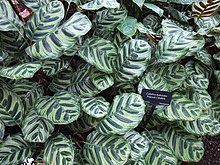Calathea makoyana, also known as peacock plant or cathedral windows, is a species of plant belonging to the genus Calathea in the family Marantaceae, native to eastern Brazil.[3] Under the synonym Goeppertia makoyana, it has gained the Royal Horticultural Society's Award of Garden Merit.[4][5]
Description
Calathea makoyana is an evergreen perennial, growing to 45 cm (18 in), with round, pale, glossy green leaves. The upper surfaces of the leaves are marked with dark green blotches along the veins, and the lower surfaces coloured deep purple, with leaf shafts that are very thin. When new leaves grow they are rolled up and display their pinkish-red undersides. Like others in the genus, it has a horizontal soil stem, rhizome, from which the plants grow up and the roots develop. It requires a minimum temperature of 16 °C (61 °F), and in temperate areas is often cultivated as a houseplant.[6]
Like other "prayer plants", this plant also raises and closes its leaves at night and opens them up again as dawn breaks.[7]
Cultivation
It grows in high humidity with temperature range between 22 and 24 °C (72 and 75 °F). As such, it is suitable for countries in Southeast Asia such as Singapore.
It should be provided with a coarse mulch of leaves, peat and sand, and soil that should be kept moist and misted throughout the summer months. Liquid fertiliser must be added every 15 days. It also needs shade or semi-shade as it cannot tolerate direct sunlight, since its leaves will become dulled and less vibrant. It must be watered with lukewarm water - preferably rainwater.
In a dry environment, it can be frequently attacked by the red spider mite that dries the tip of the leaves.[8]
Gallery
| This article uses material from the Wikipedia article Metasyntactic variable, which is released under the Creative Commons Attribution-ShareAlike 3.0 Unported License. |






